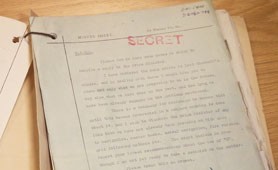The Butt Report
The Butt report was ordered by Lord Cherwell to examine the effectiveness of the RAF's night bombing campaign.

Lord Cherwell (LHS) and his friend Winston Churchill (RHS)
(photo credit: Imperial War Museum)
He chose David Miles Bensusan-Butt, an economist who, early in WW2, joined the Statistical Section of the Admiralty.
His report, published in August 1941, revealed that, over Germany, only one in four crews dropped bombs at night within 5 miles of their target. For targets in the heavily defended Ruhr, the proportion was one in ten. To make these statistics worse was the fact that these figures only referred to those crews who claimed to have reached the target. If the number of bombers actually dispatched on a raid is used then the number of bombs within 5 miles of a target has been quoted as low as 5%.

Following this highly critical report, Bomber Command was reorganised with new aircraft, new navigational aids, new tactics and new leadership.
In February 1942 Air Marshall Arthur Harris was appointed Commander-in-Chief (C-in-C) of Bomber Command.

Arthur Travers (“Bomber”) Harris, commander in chief of the Royal Air Force Bomber Command, 1942.
(photo credit: Imperial War Museum)
Future attacks were to be facilitated using a recently upgraded radio navigation system known as GEE. The first operational mission took place on the night of 8/9 March 1942 when a force of about 200 aircraft attacked Essen.
One new tactic was known as the "bomber stream." Bomber Command was hoping to overwhelm the German night air defence system by concentrating the number of aircraft and drastically reducing the duration of a raid. Earlier in the war, four hours would have been allowed for a raid by 100 aircraft but this was to be reduced to 90 mins for the "1,000 Bomber Raid" on Cologne on 30/31st May 1942.